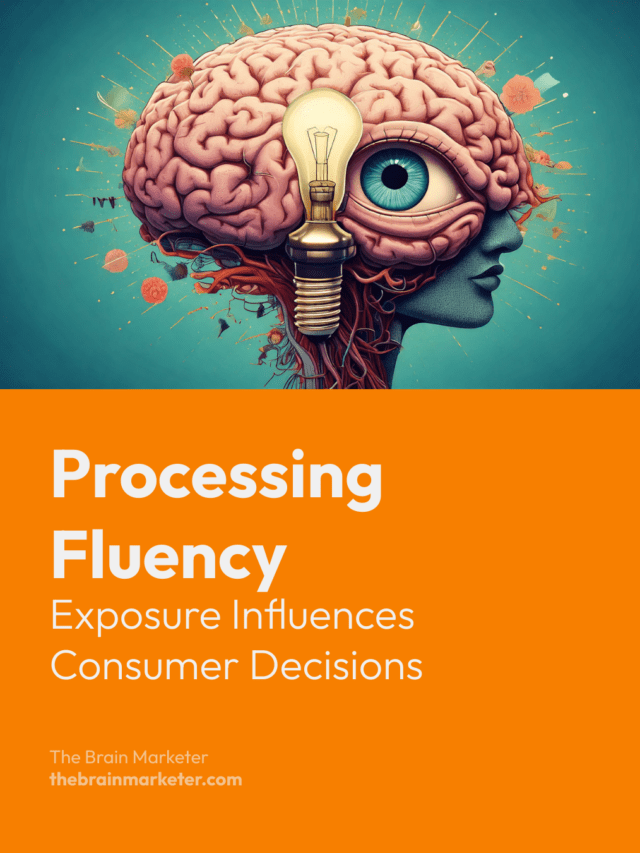Introduction
Processing fluency is a key concept in neuromarketing, helping us understand how consumers process advertising messages unconsciously. At the core of this model lies the mere exposure theory, which suggests that repeated exposure to a stimulus makes it more familiar, and therefore more accessible in memory. This familiarity leads to a preference for the stimulus, even if the consumer doesn’t explicitly recognize it. Within this framework, processing fluency is divided into two types: perceptual fluency and conceptual fluency. This article explores these mechanisms and their impact on consumer decision-making.
🎙️ Unpack the Topic with this Podcast
The Mere Exposure Theory
The mere exposure theory holds that the more a consumer is exposed to a stimulus, the more familiar it becomes, increasing the likelihood of preference, even if the consumer is unaware of it. In advertising, repeated exposure to a brand or ad message increases its familiarity, making it easier to recall and positively influencing the consumer’s attitudes.
Example: Holden and Vanhuele (1999) showed that simply hearing the name of a fictitious brand once can create an effect of false fame. A day after exposure, without explicit memory of the ad, an individual may feel that the brand already exists in the market. This sense of familiarity helps integrate the brand into the consumer’s consideration set, potentially influencing their final choice.
Processing Fluency: Perceptual vs. Conceptual
There are two types of processing fluency that play a crucial role in how consumers receive and process advertising information: perceptual fluency and conceptual fluency.
Perceptual Fluency
Perceptual fluency relates to the ease with which an individual can identify a stimulus during later encounters. It involves processing the physical characteristics of the stimulus, such as the logo shape, colors used, or the overall appearance of the product.
Example: If an ad for a fruit juice brand is presented repeatedly, the consumer will tend to recognize the brand’s packaging or logo more easily when they see it again in a store. Repetition of the stimulus or prolonged exposure enhances perceptual fluency.
Marketing Strategy: To enhance perceptual fluency, ads should use distinctive visual elements that stand out and are easy to remember, such as bright colors or simple shapes.
Conceptual Fluency
Conceptual fluency, on the other hand, refers to the ease with which a concept comes to mind. Unlike perceptual fluency, which is more superficial, conceptual fluency involves processing the meaning of the message. For instance, understanding a brand’s values or associating a product with a specific lifestyle falls under conceptual fluency.
Example: An ad for fruit juice that evokes freshness and health may remain anchored in the consumer’s memory, making this concept easily accessible when the consumer is looking for a refreshing and healthy drink.
Marketing Strategy: To enhance conceptual fluency, it’s essential to deliver clear and memorable messages that resonate emotionally or conceptually with consumers. Consistency in ad messaging is also crucial to facilitate quick access to concepts in memory.
The Unconscious Influence Process: A Nine-Step Example
To better illustrate processing fluency and its effect on consumer decision-making, let’s look at an example of an unconscious influence process from online advertising, broken down into nine steps:
Step 1
You are checking your emails online. Your goal is clear: to read your messages.
Step 2
Your attention shifts to the ad activity. A banner for a new fruit juice appears at the bottom of the screen.
Step 3
You briefly glance at the banner. The contact is quick, and you immediately forget the brand as you return to your primary activity.
Step 4
During this brief contact, you either process the physical features (perceptual fluency) of the ad (like the logo) or semantic aspects (conceptual fluency) such as the flavor of the juice.
Step 5
Repeated exposure creates a sense of familiarity with the brand.
Step 6
You then form an implicit attitude toward the brand.
Step 7
This implicit attitude is stored in your implicit memory and can be activated later, for instance, during your next shopping trip.
Step 8
Later, in a supermarket, you are not actively trying to remember the ad. Yet, contact with the logo or packaging reactivates the stored information.
Step 9
You choose the brand you saw in the ad a week earlier, even though you cannot recall the exact context of the exposure. Smile, you’re under influence!
The Importance of Processing Fluency in Marketing
Processing fluency is a powerful tool in marketing. By making a brand more accessible and familiar, it influences not only perception but also consumer decision-making. Brands can use both perceptual and conceptual fluency to make their products memorable and increase the likelihood that they are included in the consumer’s final choice.
Practical Example: “Ad bombardment” campaigns are based on the theory of processing fluency. By repeatedly exposing a consumer to an advertisement, the brand becomes more familiar, making it more likely to be chosen when encountered in-store, even if the consumer has no explicit memory of it.
Conclusion
Processing fluency is a fundamental concept for understanding how consumers receive and process advertising messages. Whether it’s perceptual fluency, dealing with physical characteristics, or conceptual fluency, dealing with meaning and associations, these mechanisms directly influence familiarity and preference for a brand. As a marketer, leveraging processing fluency helps create more effective campaigns and subtly but powerfully anchor brands in consumers’ minds.

Vincent Heimann is a marketing project manager and neuromarketing enthusiast. He founded The Brain Marketer to bridge neuroscience and marketing through accessible, science-based content. With over 10 years of experience in digital strategy, UX/UI and communication, he shares practical insights to help brands connect with the human brain — ethically and effectively

